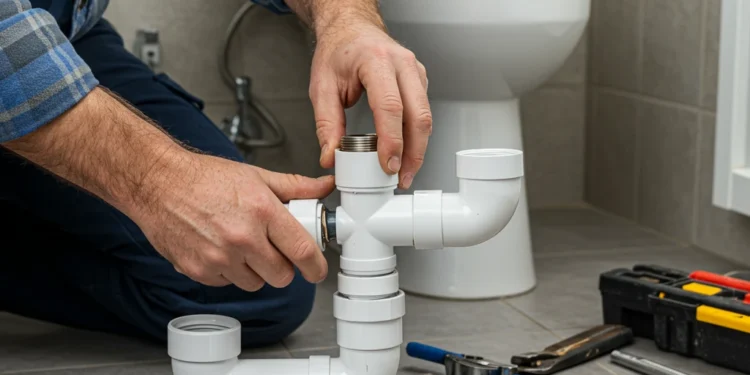Plumbing projects often face delays and extra costs when hidden pipes are damaged or misjudged. Pipe detectors make these projects more accurate by locating pipes before any digging or drilling begins. This simple step reduces mistakes, saves money, and prevents unnecessary repairs.
Modern tools can find pipes made of PVC, metal, or plastic with precision. For example, a pipe blockage detector allows workers to pinpoint clogs and leaks without tearing up walls or floors. Using a long-lasting pipe detector also helps keep projects moving smoothly over time, making it a practical investment for both small repairs and larger construction work.
By removing guesswork, pipe detectors help professionals work faster and with more confidence. They allow teams to focus on solving the problem instead of searching for it, which means less disruption and more consistent results.
Key Takeaways
- Pipe detectors reduce mistakes in plumbing projects
- They locate pipes and blockages with precision
- Long-lasting tools improve efficiency over time
Key Benefits of Pipe Detectors in Plumbing Projects
Pipe detectors give plumbers and contractors the ability to locate hidden pipes, identify leaks early, and avoid unnecessary digging. They help save time, reduce costs, and protect property by making pipe work more precise and less disruptive.
Enhancing Accuracy in Pipe Location
Accurately locating pipes is one of the main advantages of using a pipe detector. Without this technology, workers often rely on guesswork or outdated maps, which can lead to mistakes. A detector provides direct feedback about the location of PVC, metal, or other pipe materials beneath the surface.
This accuracy reduces the chance of striking a pipe during excavation. Damaging a hidden pipe can cause expensive repairs and delays. By pinpointing exact pipe positions, crews can plan their work with more confidence.
Pipe detectors also help in projects where multiple utilities are close together. Clear detection prevents confusion between water lines, gas lines, and electrical conduits, which improves safety and keeps projects on schedule.
Reducing Project Time and Costs
Pipe detectors shorten project timelines by removing the need for trial-and-error digging. Instead of spending hours searching for hidden pipes, workers can scan the area and move forward with the job. This efficiency directly lowers labor costs.
Avoiding pipe damage also saves money. Striking a pipe often leads to water loss, flooding, or emergency repairs. These setbacks not only increase expenses but also create downtime for both workers and property owners.
In addition, detectors reduce the need for large excavation areas. Smaller, targeted digging means less soil to remove and refill, cutting down on equipment use and disposal costs. Over time, these savings add up across multiple projects.
Minimizing Property Damage
One of the biggest concerns in plumbing work is the damage caused by unnecessary digging. Traditional methods often require opening large sections of floors, walls, or yards just to find a pipe. Pipe detectors limit this disruption by identifying the exact location before any cutting or digging begins.
This precision protects landscaping, flooring, and building structures. Homeowners and businesses benefit from less mess, fewer repairs, and faster project completion. It also reduces the need for cosmetic restoration after plumbing work is finished.
By minimizing property damage, detectors also help maintain the value of a home or building. Repairs are more focused, and the overall impact on the property remains smaller.
Improving Leak Detection Efficiency
Leaks can be difficult to spot because they often occur underground or behind walls. Pipe detectors improve leak detection by locating problem areas without invasive methods. They can identify changes in pressure, sound, or moisture that signal a leak.
Early detection prevents water damage and mold growth. Fixing leaks quickly also reduces water waste, which is both cost-effective and environmentally responsible.
For plumbing professionals, fast leak detection means fewer callbacks and a smoother repair process. For property owners, it means less disruption and lower utility bills. In both cases, detectors make leak management more efficient and less invasive.
How Pipe Detectors Work and Their Impact on Plumbing
Pipe detectors use different technologies to locate hidden pipes and leaks, helping plumbers avoid damage and save time. They also allow professionals to adapt their methods depending on pipe material and integrate the findings into repair or installation work.
Detection Technologies Used in Pipe Locators
Pipe detectors rely on several methods to identify the position of pipes underground or behind walls. Electromagnetic signals are often used for metallic pipes, as the signal travels through the pipe and reflects back to the receiver.
For non-metallic pipes like PVC, some detectors use ultra-high frequency radio waves or ground penetrating radar (GPR) to identify changes in soil or density. Acoustic systems are another option, listening for sound changes caused by water movement or leaks.
Each method has strengths depending on the environment. For example, electromagnetic detection works well in urban areas with metal pipes, while GPR is more effective in mixed soil conditions. By combining these technologies, plumbers can locate pipes with greater accuracy and reduce the chance of unnecessary digging.
Application Techniques for Different Pipe Materials
Different pipe materials require different approaches. Metal pipes can be traced using electromagnetic transmitters, which send a signal along the pipe’s length. The receiver then follows the signal path to map its location.
Plastic pipes present more challenges since they do not conduct electricity. In these cases, plumbers may use acoustic listening devices, tracer wires, or specialized tools like a PVC pipe detector. These tools detect variations in soil or sound patterns that indicate the pipe’s position.
When dealing with mixed systems, professionals often use a combination of techniques. For example, a tracer wire may be installed alongside plastic pipes to make them easier to detect in future projects. This prevents accidental damage and simplifies maintenance work.
Integrating Pipe Detectors with Professional Plumbing Practices
Pipe detectors fit into everyday plumbing tasks by reducing guesswork during inspections and repairs. Before excavation, plumbers use detectors to confirm the location of pipes, which helps avoid unnecessary damage to walls, floors, or landscaping.
In leak detection, detectors allow plumbers to narrow down the problem area without cutting into multiple sections of pipe. This reduces repair time and limits disruption for the property owner.
Many plumbing teams also use detectors to plan new installations. By mapping existing utilities, they can design layouts that avoid interference with current systems. This integration of detection tools with standard practices makes projects safer, faster, and more precise.
Conclusion
Pipe detectors help plumbing projects by reducing the chance of mistakes during digging and repairs. They allow teams to find pipes quickly without unnecessary excavation, which saves both time and money.
They also improve safety by lowering the risk of damaging hidden pipes that could cause leaks, flooding, or service interruptions. This makes projects more predictable and easier to manage.
Key benefits include:
- Time savings through faster pipe location
- Cost control by avoiding unnecessary digging
- Safety for workers and nearby property
- Accuracy in mapping underground systems
By using these tools, plumbing projects become more efficient and less disruptive. The technology supports better planning and helps contractors deliver work with fewer delays.












